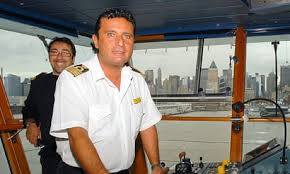Over a decade has passed since the world witnessed the shocking spectacle of the Costa Concordia, a luxury cruise liner, capsizing off the coast of Giglio, Italy, on January 13, 2012.

The disaster, which tragically claimed 32 lives, remains a stark testament to the catastrophic consequences of human error and egregious dereliction of duty. At the heart of this maritime tragedy stands Captain Francesco Schettino, a figure whose actions on that fateful night earned him global condemnation and the enduring moniker “Captain Coward.” His story is not merely one of accident but of a series of reckless decisions that led to an unimaginable loss of life and a legacy of infamy.
The events leading up to the grounding were a shocking display of bravado over safety. In a move that defied standard maritime protocols, Captain Schettino had allegedly brought his Moldovan girlfriend, Domnica Cemortan, onto the bridge, seemingly to “show off” during a dangerous “sail-by salute” maneuver near the island. Crucially, and perhaps most damningly, reports emerged that the ship’s sophisticated navigation system had been switched off, with Schettino opting for a perilous manual approach. This high-risk, low-reward deviation from the established route, executed under such negligent circumstances, directly led to the Costa Concordia striking an uncharted underwater rock, tearing a catastrophic gash in its hull.
What followed the initial impact was a chaotic and delayed response, amplified by Schettino’s initial attempts to downplay the severity of the situation to authorities and his crew. Passengers, many roused from their sleep, faced confusion and fear as the ship began to list severely. As the evacuation unfolded, it became horrifically clear that the captain, whose primary duty is to ensure the safety of all on board, had abandoned his post. Reports unequivocally placed Schettino among the first to arrive on land, leaving over 4,000 terrified passengers and crew members scrambling for their lives in the cold, dark sea.
The extent of his abandonment was underscored by the now-infamous recorded phone call with Coast Guard officer Gregorio De Falco. In a moment that encapsulated the captain’s abject failure, De Falco’s furious command, “Get back on board, damn it!”, reverberated globally, highlighting Schettino’s refusal to return to the sinking vessel and coordinate the evacuation. This direct defiance of orders from a superior officer, while thousands remained in peril, cemented his image as a man who prioritized his own safety over the lives entrusted to his care.
In the years that followed, Captain Schettino faced a relentless legal battle. He was ultimately convicted of multiple counts of manslaughter, causing a shipwreck, and abandoning ship. In 2017, after exhausting all avenues of appeal, he began serving a 16-year prison sentence.
While justice was technically served, many victims’ families and members of the public remain deeply dissatisfied, arguing that a 16-year sentence for causing the deaths of 32 people is a woefully inadequate punishment for such profound negligence and moral cowardice.
The Costa Concordia disaster served as a brutal wake-up call for the cruise industry, prompting significant revisions and enhancements to maritime safety protocols worldwide. Yet, beyond the technical improvements, the story of Captain Francesco Schettino endures as a cautionary tale of hubris, irresponsibility, and the devastating consequences when a leader abandons their most fundamental duty. The memories of that night, and the anger towards the man at the helm, continue to resonate, reminding us of the profound human cost of reckless actions at sea.



